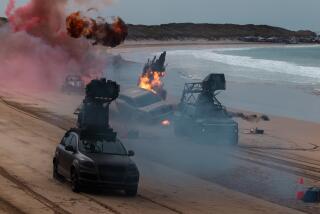Edmund DiGiulio, 76; Movie Technical Expert
- Share via
Edmund DiGiulio, the Hollywood technical wizard who helped director Stanley Kubrick give special looks to “A Clockwork Orange,” “The Shining” and “Barry Lyndon,” has died. He was 76.
DiGiulio, who earned a technical lifetime achievement Academy Award in 2002 for his contributions to film, died Friday at his Malibu home of congestive heart failure.
“I’m blown away by this,” the surprised DiGiulio said two years ago when the Gordon E. Sawyer Oscar was presented to him. Other recipients have included special effects legends Ray Harryhausen and Linwood Dunn.
One of his major contributions was the Steadicam, which is now ubiquitous in the motion picture industry. Invented by Garrett Brown, the innovative camera was developed in the mid-1970s by DiGiulio’s company, Cinema Products Corp. The Steadicam, first used in filming scenes for the 1976 “Bound for Glory,” earned a technical Oscar in 1978.
Kubrick soon found a use for the Steadicam to record Jack Nicholson stumbling into insanity in the 1980 “The Shining.”
It involved a stabilizing system that allows the camera operator to walk, run, even ride a horse or in a helicopter while producing a motion picture image as steady as if the camera were bolted to a tripod or moving on a dolly.
The system consists of a harness-like vest worn by the camera operator, attached to an arm that supports the camera by means of a free-floating gimbal. The arm, which moves on hinges and bearings, carries the weight of the camera via springs and pulleys back to the vest, making it seem weightless to the cameraman.
DiGiulio always credited Kubrick, with whom he worked on several films, for “always pushing us to come up with something. For ‘Barry Lyndon,’ ” he told Variety, “we developed very fast lenses so Stanley could shoot by candlelight.”
Educated at Columbia University, DiGiulio spent 10 years working at IBM. After pairing optics with electronics to develop a machine for Craig Research Corp. to teach reading, he was recruited by the Mitchell camera company. He helped smooth out the motors for zoom lenses, which were new then.
In 1968, he opened Cinema Products Corp., and quickly developed an award-winning through-the-lens viewing system for 35-mm studio cameras. It won the company its first Academy technical award.
Other devices DiGiulio turned out over 30 years included precise electronically controlled motors for film cameras that eased synchronization with sound recording equipment and successive 16-mm cameras that became standard tools for television news crews.
Even after his original “CP 16s” became outdated, they were used for some films, including “The Blair Witch Project” in 1999.
DiGiulio was chairman of the Academy’s Scientific and Technical Committee for five terms.
He is survived by his wife, Louise; a daughter, Amanda Richmond; and one granddaughter.
More to Read
Only good movies
Get the Indie Focus newsletter, Mark Olsen's weekly guide to the world of cinema.
You may occasionally receive promotional content from the Los Angeles Times.










